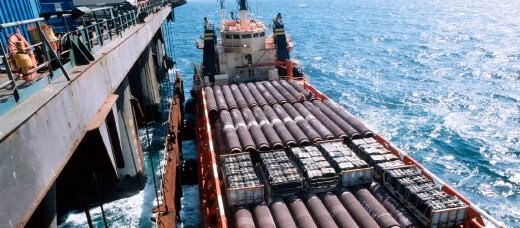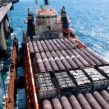
Nord Stream Pipeline Project Still Short of Resources
Publication: Eurasia Daily Monitor Volume: 6 Issue: 209
By:

Four years after Germans and Russians signed the founding agreement (October 2005), the Nord Stream pipeline project has received the Scandinavian countries’ approval for construction on the Baltic seabed, from Russia to Germany. The Gazprom-led project, however, has not yet lined up the gas and investment resources. Moreover, the pipeline construction schedule through 2015 seems only loosely correlated with the availability of Russian gas resources.
Nord Stream’s construction schedule envisages completing the first stage in late 2011 with an annual capacity of 27.5 billion cubic meters (bcm); completing the second stage by late 2014 with the same capacity; and reaching the full annual capacity of 55 bcm by 2015.
The Russian gas field dedicated to Nord Stream is Yuzhno-Russkoye, in western Siberia’s Tyumen oblast. The earmark dates back to 2005 when the Nord Stream project agreement was signed. The field’s commercially viable reserves are estimated at 600 million cubic meters (www.wintershall.de, www.eon-ruhrgas.com.de, www.nord-stream.com/de). That volume is going to be shared by German users –Wintershall and Ruhrgas– with Gazprom during the life of the Nord Stream project. Yuzhno-Russkoye’s reserves would probably not suffice to fill even the first of Nord Stream’s two lines. Thus, the issue of ensuring full supplies for Nord Stream remains unresolved.
Russian authorities are undoubtedly aware of this situation. In 2006, then President Vladimir Putin publicly offered to export a large share of the Shtokman field’s future production to Germany, including a portion through the Nord Stream pipeline. Shtokman, the supergiant Arctic field located far offshore in the Barents Sea, holds reserves estimated at nearly 4 trillion bcm, with discouragingly high costs of development. There is no known feasibility study and no investment decision in sight. Gazprom has enlisted Norway’s StatoilHydro and Total of France as partners to develop Shtokman; but the conditions –including transfers of advanced technologies to Russia– are far from agreed thus far. A start to commercial production is generally deemed unlikely before 2020.
Meanwhile, Gazprom speaks of using Shtokman’s future production mainly for liquefaction and export to North America, as part of Gazprom’s strategy to break into the global LNG (liquefied natural gas) trade (Vedomosti, October 22). Such statements need not be taken at face value. They are often meant to play off Western partners against each other; and are also subject to change in response to market trends. What does seem likely, however, is that Shtokman gas will not be available in time to fill Nord Stream to the declared capacity of the pipeline within the declared schedule of its completion.
Apparently reflecting pessimism about Shtokman’s outlook, Prime Minister Vladimir Putin avoided discussing that project when he invited top foreign companies to consider an equally vast plan for Northern Yamal gas development. The companies’ response was notably reserved (EDM, September 25). Thus far, Moscow is not linking the issue of developing Northern Yamal with the issue of sourcing Nord Stream. Geological conditions at Northern Yamal, with unfathomable development costs and duration, would seem to rule out gas inputs from there long after Nord Stream’s desired completion date.
Meanwhile, Moscow is hinting that it might prioritize Gazprom’s South Stream project –the pipeline on the seabed of the Black Sea to southern and central Europe– rather than Nord Stream (see below). This would seem deliberately to imply a zero-sum game between the two projects, vying for Russia’s finite gas and investment resources. Given Russia’s stagnant gas production and the declining potential of its main fields currently in operation (except for Siberia’s east and far east), the goal of filling Nord Stream by 2015 as planned seems out of reach.
The financing of Nord Stream’s construction also seems far from lined up at this juncture. Cost estimates range from 7.5 billion Euros (the project consortium’s official figure) to $11 billion (European analysts’ often-quoted estimate). According to the project’s general manager Matthias Warnig, the consortium has spent approximately 2 billion Euros on steel pipes for the first of Nord Stream’s two lines; and it needs another 4 billion Euros for both lines’ steel pipes. Warnig hopes to raise 70 percent of the total project financing from banks, presuming German government guarantees for 1.5 billion Euros and Italian government guarantees for much of the remainder (Handelsblatt, October 9).
Those Italian credit guarantees –if they materialize– stand to be rewarded with business contracts for the Nord Stream project. Italian firms have been designated to manufacture some of the steel pipes, build the compressor station at Portovaya near St. Petersburg, and lay pipes on the Baltic seabed (IL Sole-24 Ore, October 30; Sueddeutsche Zeitung, November 10).
Italy’s involvement with Nord Stream underscores the emergence of a tripartite, Russo-German-Italian pipeline alliance to outflank Europe through the Nord Stream and South Stream projects. In this grouping, Russia alone operates as a state actor with integrated economic and political strategies. The German actors are interest groups driven by compartmentalized business strategies, though capable of influencing the government; while the Italian participants are companies linked with Moscow-friendly Silvio Berlusconi’s government.
Meeting with Berlusconi recently to promote the South Stream project, Russian Prime Minister Vladimir Putin predicted that “South Stream has every chance to be completed before Nord Stream” (Interfax, October 23; Vedomosti, November 6). The Kremlin uses those shifting signals to play off various consumer countries against each other while Russia’s gas export potential stagnates and Gazprom clearly lacks investment resources proportionate to its declared commitments and projects.




